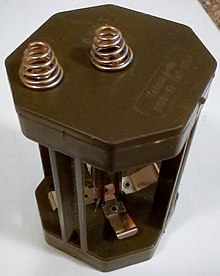Lantern battery
Lantern battery , block battery , tent lamp battery , 4R25 and 430 are common names for a standardized size of batteries that is widely used in North America . Areas of application include warning lights and, in some cases, hand lamps . The design and electrical parameters are standardized in the IEC 60086 standard.
construction
It is a block with a side length of approx. 65 mm × 65 mm and a height of approx. 110 mm. Internally, four battery cells of 1.5 V each are electrically connected in series , which means that an open circuit voltage of 6 V is achieved. The connection is made via spiral spring contacts that lead out of the housing at the top.
Electrochemical system
The battery is manufactured with different electrochemical systems that differ in capacity and load capacity. Zinc-carbon - with 7.0 Ah to 8.5 Ah and alkaline primary cells with around 15 Ah are commercially available.
application
Lantern batteries are primarily used in larger portable electrical devices. They are preferably used for lighting in camping, construction sites, agriculture and others, for example in alarm systems, safety devices, flashing and permanent lights. The design is also available as a rechargeable lead-gel battery. There are also adapters that allow the use of four mono cells .
Individual evidence
- ↑ International Electrotechnical Commission [IEC] (Ed.): IEC 60086-SER . Primary Batteries. IEC, Geneva ( webstore.iec.ch ).
- ↑ all-batteries.de (PDF; 463 kB)


